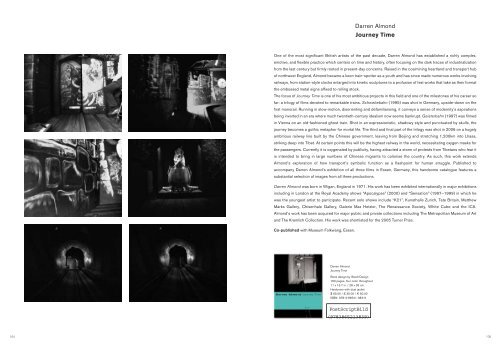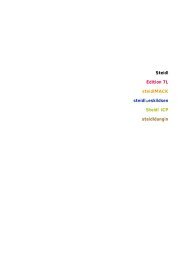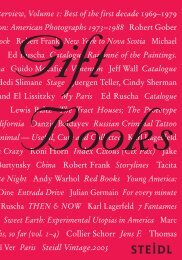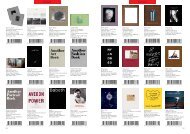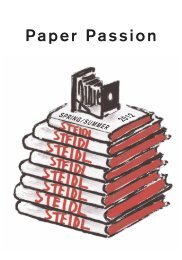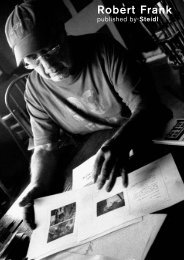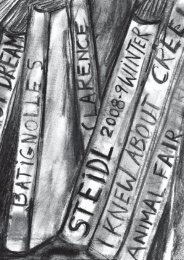Germany. The home of the Swedish photobook. Greger Ulf ... - Steidl
Germany. The home of the Swedish photobook. Greger Ulf ... - Steidl
Germany. The home of the Swedish photobook. Greger Ulf ... - Steidl
You also want an ePaper? Increase the reach of your titles
YUMPU automatically turns print PDFs into web optimized ePapers that Google loves.
104<br />
Darren Almond<br />
Journey Time<br />
One <strong>of</strong> <strong>the</strong> most significant British artists <strong>of</strong> <strong>the</strong> past decade, Darren Almond has established a richly complex,<br />
emotive, and flexible practice which centers on time and history, <strong>of</strong>ten focusing on <strong>the</strong> dark traces <strong>of</strong> industrialization<br />
from <strong>the</strong> last century but firmly rooted in present-day concerns. Raised in <strong>the</strong> coalmining heartland and transport hub<br />
<strong>of</strong> northwest England, Almond became a keen train-spotter as a youth and has since made numerous works involving<br />
railways, from station-style clocks enlarged into kinetic sculptures to a pr<strong>of</strong>usion <strong>of</strong> text works that take as <strong>the</strong>ir format<br />
<strong>the</strong> embossed metal signs affixed to rolling stock.<br />
<strong>The</strong> focus <strong>of</strong> Journey Time is one <strong>of</strong> his most ambitious projects in this field and one <strong>of</strong> <strong>the</strong> milestones <strong>of</strong> his career so<br />
far: a trilogy <strong>of</strong> films devoted to remarkable trains. Schwebebahn (1995) was shot in <strong>Germany</strong>, upside-down on <strong>the</strong><br />
first monorail. Running in slow-motion, disorienting and defamiliarising, it conveys a sense <strong>of</strong> modernity’s aspirations<br />
being inverted in an era where much twentieth-century idealism now seems bankrupt. Geisterbahn (1997) was filmed<br />
in Vienna on an old-fashioned ghost train. Shot in an expressionistic, shadowy style and punctuated by skulls, <strong>the</strong><br />
journey becomes a gothic metaphor for mortal life. <strong>The</strong> third and final part <strong>of</strong> <strong>the</strong> trilogy was shot in 2006 on a hugely<br />
ambitious railway line built by <strong>the</strong> Chinese government, leaving from Beijing and stretching 1,200km into Lhasa,<br />
striking deep into Tibet. At certain points this will be <strong>the</strong> highest railway in <strong>the</strong> world, necessitating oxygen masks for<br />
<strong>the</strong> passengers. Currently it is oxygenated by publicity, having attracted a storm <strong>of</strong> protests from Tibetans who fear it<br />
is intended to bring in large numbers <strong>of</strong> Chinese migrants to colonise <strong>the</strong> country. As such, this work extends<br />
Almond’s exploration <strong>of</strong> how transport’s symbolic function as a flashpoint for human struggle. Published to<br />
accompany Darren Almond’s exhibition <strong>of</strong> all three films in Essen, <strong>Germany</strong>, this handsome catalogue features a<br />
substantial selection <strong>of</strong> images from all three productions.<br />
Darren Almond was born in Wigan, England in 1971. His work has been exhibited internationally in major exhibitions<br />
including in London at <strong>the</strong> Royal Academy shows “Apocalypse” (2000) and “Sensation” (1997–1999) in which he<br />
was <strong>the</strong> youngest artist to participate. Recent solo shows include “K21”, Kunsthalle Zurich, Tate Britain, Mat<strong>the</strong>w<br />
Marks Gallery, Chisenhale Gallery, Galerie Max Hetzler, <strong>The</strong> Renaissance Society, White Cube and <strong>the</strong> ICA.<br />
Almond’s work has been acquired for major public and private collections including <strong>The</strong> Metropolitan Museum <strong>of</strong> Art<br />
and <strong>The</strong> Kramlich Collection. His work was shortlisted for <strong>the</strong> 2005 Turner Prize.<br />
Co-published with Museum Folkwang, Essen.<br />
Darren Almond<br />
Journey Time<br />
Book design by <strong>Steidl</strong> Design<br />
160 pages, four color throughout<br />
11 x 13.7 in. / 28 x 35 cm<br />
Hardcover with dust jacket<br />
$ 65.00 / £ 35.00 / € 50.00<br />
ISBN: 978-3-86521-383-9<br />
PostScript Bild<br />
(9783865213839)<br />
105


